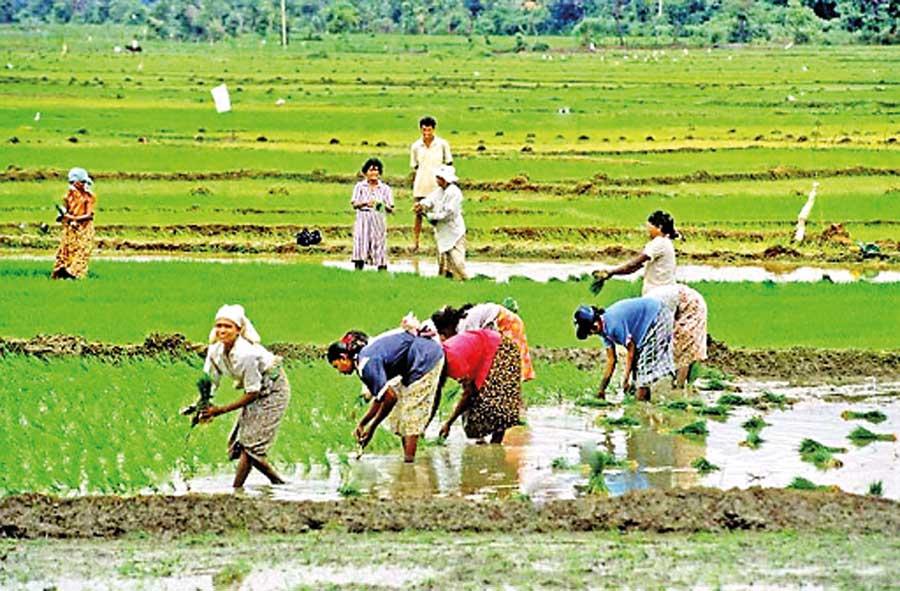Reply To:
Name - Reply Comment

Agricultural activities crawl back to normal after COVID-19 shutdown
Economies around the world are in free fall with a great economic depression triggered by the COVID-19 disaster and prolonged capitalist crisis. Our economic, social and political world as we have known it is going to drastically change. Amidst such a depression, what is in store for the rural world long neglected by the urban centred visions of development?
Economic depression
As economic growth data for the quarter year from April to June 2020 are released, the severity of the economic  crisis is sinking in. The Indian economy shrunk by 23.9% and the UK’s economy shrunk by 20.4% during that quarter. The devastating impact on India’s economy is telling of what the developing world is going to face. While manufacturing is normally considered to be the engine of growth for developing countries, in India it has fallen by 39.3%. The only saving grace in the Indian economy is agriculture, which grew by 3.4%.
crisis is sinking in. The Indian economy shrunk by 23.9% and the UK’s economy shrunk by 20.4% during that quarter. The devastating impact on India’s economy is telling of what the developing world is going to face. While manufacturing is normally considered to be the engine of growth for developing countries, in India it has fallen by 39.3%. The only saving grace in the Indian economy is agriculture, which grew by 3.4%.
In an article in the Indian outlet, The Wire, on April 20, 2020, Devaka Gunawardena and I, had the following to say about the World Bank Report on South Asia released a week before our article, the dangers facing the Indian economy and the ignorance of the Sri Lankan economic establishment:
“The World Bank Report gives a relatively rosy prediction for GDP growth in India of 1.5% to 2.8% over the next year. However, two Indian economists, Kanitkar and Jayaraman, using their input-output model predict that depending on the length of lockdown, between 13 days and 67 days, the loss to GDP could be between 7% and 33%. Indeed, it is common sense that every day of curfew, which results in the loss of production of goods and services, will hit GDP growth. With its positive growth predictions, the Sri Lankan economic establishment appears to lack even basic common sense in understanding the dynamics of the crisis.”
This is not just about saying we told you so, rather, recognising the lack of capacity and foresight of the economic establishment to understand the tremendous political economic changes underway.
While Sri Lanka’s economic growth data for the second quarter is likely to be released in the weeks ahead, the situation looks dismal. First quarter economic data for the months January to March 2020, already showed that the economy had shrunk by 1.6%. And the Index of Industrial Production released for the second quarter for the months of April to June 2020, show that manufacturing compared to the quarter a year earlier has shrunk by 28.6%.
Some analysts are claiming this is a temporary downturn due to the lockdown and that there will be a V-shaped recovery in the months ahead. However, I argue that economies cannot recover quickly from such tremendous crisis; capitalist growth is dependent on profits and expectations about profits, which together drive investment necessary for future growth. In India during the quarter we are discussing, gross fixed capital formation, a measure of investment, contracted by 52.9%.
Agriculture to the fore
For reasons of both economic growth and critical importance of the food system during a depression, agriculture abandoned for decades by neoliberal policies, is being highlighted by policy makers. Historically, during the decades after independence from colonial rule, developing states attempted to use the surplus extracted from  agricultural towards investment in the industrial and urban sectors. During the last four decades of neoliberal globalisation, rural economies were undermined by a focus on export-led manufacturing and the expansion of urban real estate and tourism development, with state supported measures of land grabs and dispossession of farming communities.
agricultural towards investment in the industrial and urban sectors. During the last four decades of neoliberal globalisation, rural economies were undermined by a focus on export-led manufacturing and the expansion of urban real estate and tourism development, with state supported measures of land grabs and dispossession of farming communities.
In this context, with the Sri Lankan Government emphasising agricultural production, what would the rural economy look like with the major political economic shift in the country? Would it be only about policies of increasing agricultural production to support the urban communities and bolster a collapsing economy, or would it also lead to re-imaging the welfare of rural society? The answer to this will depend as much on the struggles of the rural people and how they organise themselves.
"Existing rural producers and those returning to the rural space thrown out by the collapse of urban employment and falling demand for migrant labour, are already counting on eking out livelihoods through agriculture"
Even as we think about what a return to the rural could look like, I must say at the outset that there is going to be tremendous economic suffering in the years ahead, which can only be addressed by drastic measures of wealth redistribution. Meeting the essential needs of the people in the entire country needs to be a priority even as we consider reforms to address the long injustice towards our rural communities.
Existing rural producers and those returning to the rural space thrown out by the collapse of urban employment and falling demand for migrant labour, are already counting on eking out livelihoods through agriculture. The mounting involvement in farming, particularly with the rain-fed Maha season, comes with the risks of natural disasters such as a drought or bad monsoon rains, as seen during recent times with climate change. Rural communities could be devastated with increased indebtedness; particularly in the event of crop failures after increased cultivation. Thus urgent avenues of agricultural credit with some backing from the state to address the risk facing farmers is a priority.
New deal for rural
If the political economic transformation underway is going to be a prolonged shift towards the rural, what should constitute rural political visions and demands? In the absence of such a political vision, it may well end up another era of surplus extraction for the benefit of the rural/urban elite and the large agri-business corporate, whom together have exploited the small rural producers for decades. An emancipatory rural politics, on the other hand,should seek to redress the great inequalities entrenched over decades.
A new deal for the rural should include appropriate supports for small producers. Credit needs, access to land and water, supply of inputs, agricultural machinery, storage facilities, value-adding small industries and avenues of marketing with fair prices should be essential elements of a agricultural transformation programme determined by the rural communities themselves.
A new deal for the rural, recognising the contribution towards feeding and addressing the existential needs of the country, should focus on public investment in rural infrastructure and distribution of resources; including land for the landless, small tanks and other small irrigation projects, access to lagoons and seas for fisher-folk, landing sites and fisheries harbours, rural roads and public transport facilities, and rural housing, schools and healthcare facilities. Even as we face the most severe economic crisis in our independent history, should we also not imagine a future of economic justice for those who produce our sustenance?